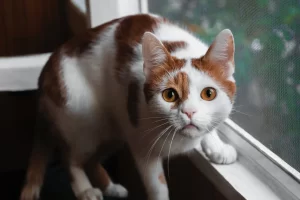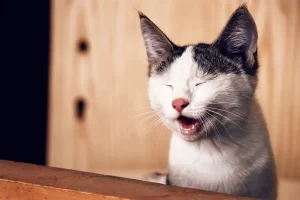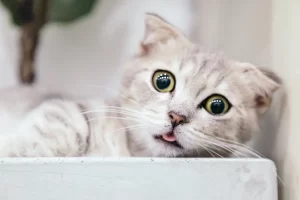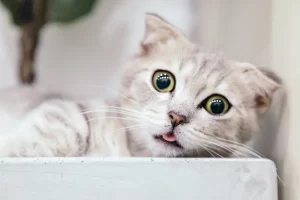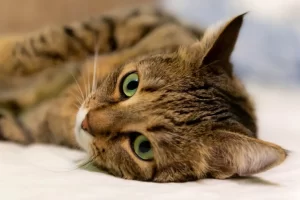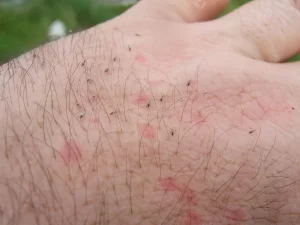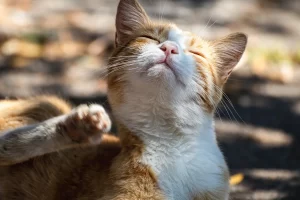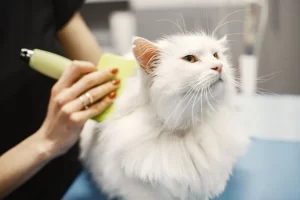Vomiting is a common occurrence in cats and can be caused by various factors, ranging from mild to serious. One important aspect to consider when assessing cat vomit is its color. The color of cat vomit can provide valuable clues about the underlying cause of the vomiting, helping cat owners and veterinarians better understand the nature of the issue at hand. In this article, we will explore different colors of cat vomit, including green, brown, red, white, yellow, and more, and discuss their potential significance in determining the cause of vomiting in cats.
Table of Contents
ToggleCat Vomit Color: What does it show?
Cat Throwing Up Green Liquid
Green liquid vomit in cats is typically caused by the presence of bile, which is a digestive fluid produced by the liver. Bile is usually yellow or green in color, and its presence in puke may indicate that the cat’s stomach is empty and the bile is being expelled. This can occur due to the cat vomiting on an empty stomach or having rapid gastric emptying. It can also be a sign of gastrointestinal issues or food intolerance.
Cat Vomiting Green Bile
Green bile vomit is typically a darker shade of green and may indicate that the bile is coming from the small intestine. It can be a sign of more significant gastrointestinal problems, such as an obstruction or inflammation in the small intestine.
Cat Puking Brown Vomit
Brown vomit in cats may indicate that the cat has ingested something that is not easily digested, such as a hairball or foreign object. Brown vomit can also be caused by the presence of blood in the vomit, which may indicate bleeding in the gastrointestinal tract. It can be a cause for concern and should be evaluated by a veterinarian.
Cat Throwing Up Brown Liquid
Brown liquid vomit may be a sign of dehydration or a digestive issue, such as an upset stomach or inflammation of the stomach lining. It can also be indicative of the presence of partially digested food mixed with gastric juices.
Cat Throwing Up Dark Brown
Dark brown vomit in cats can indicate the presence of partially digested blood, which may be a sign of bleeding in the upper gastrointestinal tract or other internal issues. It may require immediate veterinary attention to determine the underlying cause.
Cat Puking Red
Red vomit in cats may indicate the presence of blood, which can be a sign of various conditions, including gastrointestinal bleeding, stomach ulcers, or ingestion of a foreign object. The color of the blood may vary, ranging from bright red to darker shades of red, and may require prompt veterinary evaluation and treatment.
Cat Vomiting Red Liquid
Red liquid vomit may also indicate the presence of blood, which should be taken seriously and may require immediate veterinary attention. It can be a sign of a serious condition and should not be ignored.
Cat White Vomit
White vomit in cats may be foamy in nature and can indicate that the cat’s stomach is empty or that there is an excess of stomach acid. It can also be caused by the expulsion of mucus from the respiratory tract, especially if the cat has been coughing or experiencing nasal congestion.
Cat Throwing Up White Foam
White foamy vomit may indicate the presence of excess stomach acid or irritation of the stomach lining. It can also be caused by the cat eating too quickly or swallowing air while eating, leading to the formation of foam in the vomit.
Cat Throwing Up Yellow Liquid
Yellow liquid vomit in cats can be a sign of bile mixed with stomach contents and may indicate that the cat’s stomach is empty or that there is a problem with the liver or gallbladder. It can be a sign of gastrointestinal issues or liver dysfunction that requires further evaluation by a veterinarian.
Cat Throwing Up Orange Liquid
Orange liquid vomit can indicate the presence of bile mixed with stomach contents, similar to yellow vomit. It may suggest digestive issues or problems with the liver or gallbladder that require veterinary attention for proper diagnosis and treatment.
Cat Throwing Up Pink Liquid
Pink vomit in cats can indicate the presence of blood, which may be from bleeding in the gastrointestinal tract or other internal issues. The color may vary from light pink to a darker hue and should be evaluated by a veterinarian to determine the underlying cause.
Cat Black Vomit
Black vomit may indicate the presence of digested blood, which can be a sign of bleeding in the upper gastrointestinal tract, such as the stomach or esophagus. It may also indicate the ingestion of dark-colored substances, such as charcoal or certain medications. Black vomit should be taken seriously and evaluated by a veterinarian promptly.
Cat Gray Vomit
Gray vomit in cats may indicate the presence of partially digested food mixed with gastric juices. It can also be seen in cats who have ingested certain medications or have a history of eating inappropriate items. Gray vomit may require veterinary evaluation to determine the underlying cause and appropriate treatment.
Cat Purple Vomit
Purple vomit in cats is uncommon but may be indicative of bleeding in the gastrointestinal tract. It can be a sign of a serious condition and should be evaluated by a veterinarian promptly.
Other related reads: Types of Cat Vomits
Foamy Vomit in Cats: Understanding the Possible Causes
If your cat’s vomit is foamy, it may be because of these reasons:
- Gastric irritation: Foamy vomit may be a result of irritation of the stomach lining, which can be caused by various factors such as overeating, consuming food too quickly, or ingesting something that doesn’t agree with the cat’s digestive system. The stomach may produce excess gastric juices, leading to the formation of foam in the vomit.
- Regurgitation: Cats are known to regurgitate or bring up food from their esophagus without true vomiting. This can result in foamy vomit, as the food is not fully digested and mixed with stomach contents before being expelled. Regurgitation can be caused by a variety of factors, such as eating too quickly, eating large amounts of food, or consuming hairballs.
- Gastroesophageal reflux: Foamy vomit can also be a result of gastroesophageal reflux, which is the backward flow of stomach contents into the esophagus. This can happen when the lower esophageal sphincter, a muscular ring that normally keeps stomach contents in the stomach, is weakened or relaxed. Gastroesophageal reflux can cause irritation and foam formation in the vomit.
- Respiratory issues: In some cases, foamy vomit in cats can be associated with respiratory issues, such as coughing or sneezing, which can result in the expulsion of mucus or saliva along with air, leading to foamy vomit. Help your cat that sneezes a lot by taking advantage of these home remedies.
Other related reads: Cat vomit color chart
Cat Throwing Up and Not Eating: Causes and Tips
Cat Throwing up Yellow Bile and Not Eating:
If a cat is throwing up yellow bile and refusing to eat, it may indicate that the cat’s stomach is empty and the bile is irritating the stomach lining. This can happen when a cat goes without food for an extended period of time, leading to increased stomach acidity and bile production. The yellow color in the vomit is due to the presence of bile, a digestive fluid produced by the liver.
Not eating, along with vomiting yellow bile, can lead to dehydration and nutritional deficiencies in cats. It’s important to address this issue promptly by offering small, frequent meals of a balanced and appropriate diet for cats. If the cat continues to refuse food or vomits persistently, it’s best to consult a veterinarian for further evaluation and appropriate treatment.
Cat Vomiting Green Bile and Not Eating:
If a cat is vomiting green bile and not eating, it may indicate a more severe form of stomach irritation. Green bile in vomit can suggest that the vomit is originating from the small intestine, as bile is normally produced in the liver and stored in the gallbladder before being released into the small intestine for digestion.
Vomiting green bile and refusing to eat can be a sign of gastrointestinal issues such as inflammation, infection, or obstruction. It’s crucial to seek veterinary attention promptly to determine the underlying cause and provide appropriate treatment to alleviate the cat’s discomfort and prevent further complications.
Cat Throwing up Yellow Liquid and Not Eating:
If a cat is throwing up yellow liquid and not eating, it may indicate that the cat’s stomach is empty and the vomit is primarily composed of stomach juices. This can occur when a cat has gone without food for a prolonged period of time or has an underlying gastrointestinal issue that is causing reduced appetite and vomiting.
Not eating, along with vomiting yellow liquid, can lead to dehydration and malnutrition in cats. It’s important to address the underlying cause and offer small, frequent meals of a balanced and appropriate diet for cats. If the cat continues to refuse food or vomits persistently, veterinary attention should be sought for proper evaluation and management.
If your cat is vomiting and not eating, you may want to look into these treatments.
Cat Throwing Up Undigested Food: What is the Reason?
Vomiting undigested food in cats can be concerning and may indicate various underlying issues. The color of vomit can provide clues to the potential cause. If your cat is throwing up undigested food, the color of the vomit can vary depending on the type of food and the length of time it has been in the stomach.
If the vomit appears yellow or contains yellowish bile, it may suggest that the food has been in the stomach for some time and has undergone partial digestion. This can occur when the food stays in the stomach for an extended period or is regurgitated after it has been partially broken down by stomach acid. On the other hand, if the vomit appears to be relatively fresh and resembles the color and texture of the food that was consumed, it may suggest that the food was vomited shortly after being ingested and has not undergone much digestion.
It’s important to note that vomiting undigested food can be normal in certain situations, such as when a cat eats too quickly or consumes an unusually large meal. However, if your cat is consistently vomiting undigested food, it may indicate an issue with the digestive system, such as gastric motility disorders, food allergies, or other gastrointestinal conditions. It’s crucial to monitor your cat’s vomiting closely, note the color and consistency of the vomit, and consult your veterinarian for proper evaluation, diagnosis, and treatment.
Frequently Asked Questions (FAQs) of Cat Vomiting or Throwing Up
Is it normal for my cat to vomit white foamy liquid?
White foamy vomit in cats can be caused by excess saliva or stomach mucus, which may be seen when the stomach is empty or irritated.
Why is my cat’s vomit yellow or orange in color?
Yellow or orange vomit in cats can indicate the presence of bile, which is a digestive fluid produced by the liver and stored in the gallbladder. It may suggest issues with digestion or liver function.
Can stress or anxiety cause my cat to vomit?
Yes, stress or anxiety can trigger vomiting in cats, as it can affect their digestive system and overall well-being.
What are some common causes of cat vomiting?
Common causes of cat vomiting include dietary indiscretion, hairballs, food allergies, foreign object ingestion, gastrointestinal infections, and medical conditions such as kidney disease or pancreatitis.
Should I be concerned if my cat vomits occasionally?
Occasional vomiting in cats may not be a cause for concern, as cats can vomit from time to time due to various reasons. However, if vomiting becomes frequent, persistent, or is accompanied by other symptoms, it may indicate an underlying issue that requires veterinary attention.
When should I seek veterinary care for my cat’s vomiting?
You should seek veterinary care if your cat’s vomiting is persistent, frequent, contains blood, or is accompanied by other symptoms such as lethargy, loss of appetite, dehydration, abdominal pain, or changes in behavior.
How can I prevent my cat from vomiting hairballs?
Regular grooming and brushing can help reduce the amount of hair your cat ingests, which may help prevent hairballs. Additionally, feeding a hairball control diet or providing hairball prevention treats can also be helpful.
Can changes in my cat’s diet cause vomiting?
Yes, sudden changes in your cat’s diet or feeding routine can disrupt their digestive system and potentially cause vomiting. It’s important to introduce dietary changes gradually and monitor your cat’s response.
Can my cat vomit due to food allergies?
Yes, food allergies can cause vomiting in cats. Identifying and eliminating the allergenic food from your cat’s diet with the guidance of your veterinarian may help alleviate the issue.
What should I do if my cat vomits undigested food?
If your cat is vomiting undigested food, it may indicate that they are eating too quickly or not properly chewing their food. You can try feeding smaller, more frequent meals and encouraging your cat to eat slowly. Providing puzzle feeders or food-dispensing toys can also help slow down your cat’s eating pace and promote better digestion.
Can my cat vomit due to hairball formation?
Yes, hairballs can cause vomiting in cats, especially in long-haired breeds. Regular grooming and brushing can help prevent excessive hair ingestion, and specialized hairball control diets or treats may also be beneficial.
Is it normal for my cat to vomit after eating grass?
Cats often eat grass to help induce vomiting and aid in digestion. However, if your cat is frequently vomiting after eating grass, it may indicate an underlying issue such as an upset stomach or gastrointestinal irritation.
Can medications or supplements cause vomiting in cats?
Yes, certain medications or supplements can cause vomiting in cats, especially if they are not properly administered or if your cat has an adverse reaction to them. Always consult with your veterinarian before giving any medication or supplement to your cat.
What should I do if my cat vomits frequently or has chronic vomiting?
If your cat vomits frequently or has chronic vomiting, it is important to consult your veterinarian for proper diagnosis and treatment. Your vet may need to perform diagnostic tests such as bloodwork, x-rays, or ultrasounds to determine the underlying cause and develop an appropriate treatment plan.



